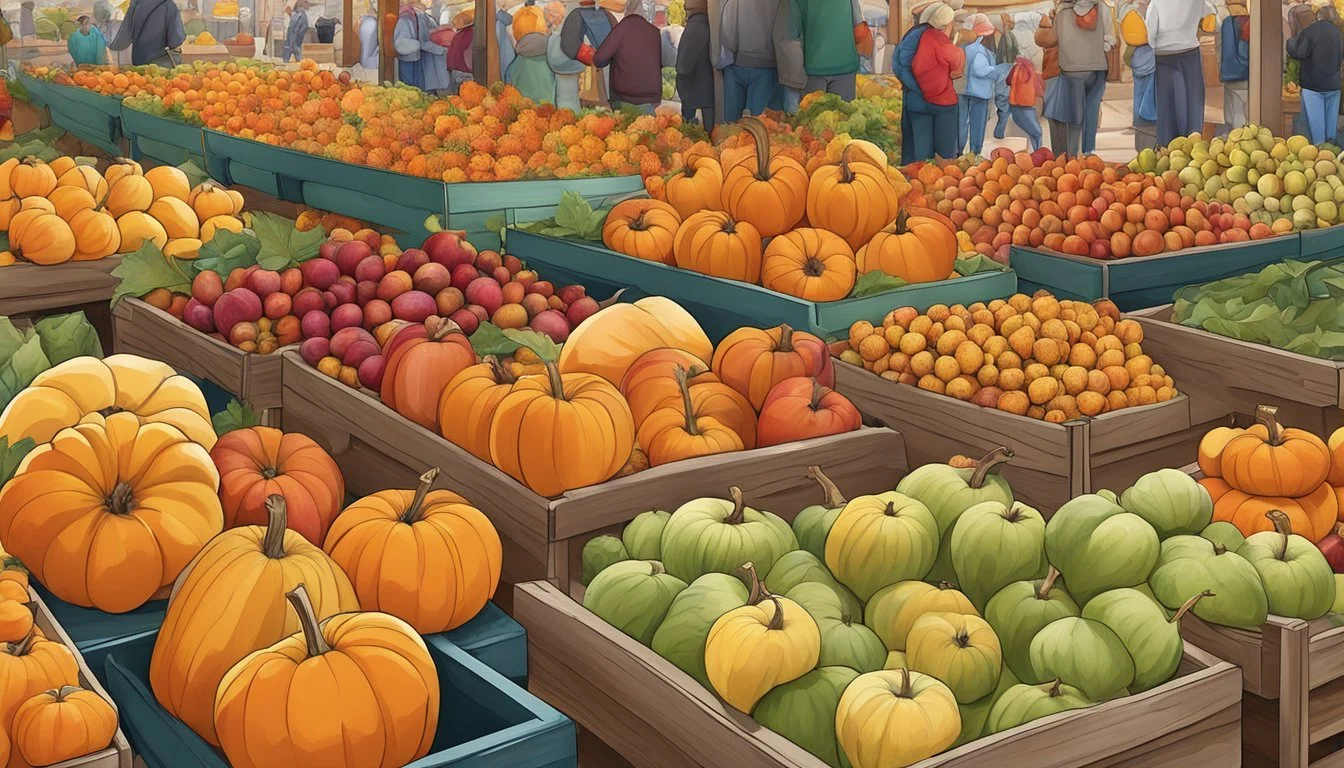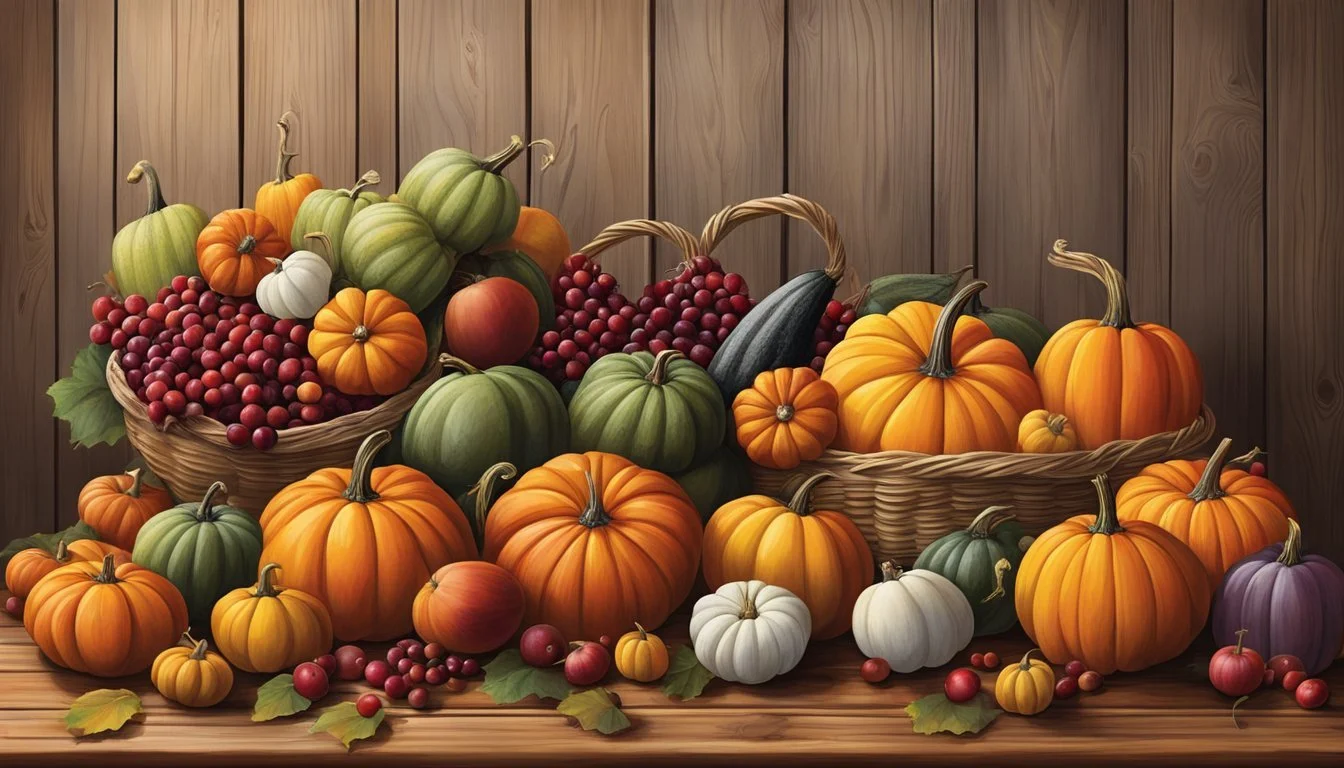Wisconsin Seasonal Fruit & Vegetables in October
A Guide to Autumn Harvest
This Article is Part of our Wisconsin Seasonal Fruit & Veg Calendar
In Wisconsin, October presents a season of harvest and an abundance of fresh produce. The state's farmers' markets and local groceries are teeming with the best fruits and vegetables the autumn soil has to offer. Wisconsin's climate, marked by warm summer days and crisp autumn nights, contributes to the unique flavor profiles of its produce, making it a tempting time for locals and visitors alike to explore the state’s agricultural offerings.
October's bounty includes a variety of apples, from the tart Granny Smith to the sweet and crisp Fuji, all ripe for the picking. These apple varieties, among others, are not only perfect for eating fresh but also ideal for autumnal recipes like apple crisps and pies. Beyond orchard fruits, the fields yield root vegetables, such as beets (how long do beets last?), and leafy greens like kale, which are at their nutritional peak during the cooler months.
The seasonal shift into cooler temperatures allows for the continued harvest of some summer crops, which linger into the early days of October, while also introducing the fully ripened fall selections. Thus, Wisconsin's produce calendar in October offers a rich tapestry of flavors and a multitude of options for seasonal cooking and eating. Whether used in traditional recipes or enjoyed as fresh, raw delights, the seasonal produce of Wisconsin in October symbolizes the harvest season's abundance and diversity.
Assessing Wisconsin's Seasonal Climate
In October, Wisconsin's agricultural landscape responds significantly to the climate's seasonal shifts, affecting crop viability and harvest timelines.
The Impact of October Weather on Crops
Wisconsin's weather in October is characterized by cooler temperatures and the preparation for the first frost, which can occur during this month. Farmers monitor the dropping temperatures closely as they can impact the quality and yield of crops still in the fields. For instance, hardy vegetables thrive in these conditions, while other more sensitive crops may need to be harvested before a frost.
Hardy Vegetables:
Broccoli (how long does broccoli last?)
Brussels Sprouts (how long do brussels sprouts last?)
Kale
Sensitive Crops:
Tomatoes
Peppers
Season Transition: From Summer to Fall
As Wisconsin transitions from the warm summer season to the cooler fall, there is a noticeable change in the types of crops that are harvested. Apple varieties, such as the Honeycrisp or McIntosh, reach peak ripeness and make their way to markets. Meanwhile, crops traditionally associated with summer, like sweet corn, have ended their season.
Apple Varieties:
Honeycrisp
McIntosh
Empire
End of Summer Crops:
Sweet Corn
Zucchini
This shift not only influences the agricultural practices but also the accessibility of seasonal produce to consumers.
Seasonal Fruit Highlights
Wisconsin's October harvest brings a spectacular variety of fruits, each with its own distinct flavors and culinary uses. From the diverse apple varieties to the rich, late-season berries, and the distinct taste of fall's signature grapes and cranberries, Wisconsin's fruit landscape in October is vibrant and rich.
Apple Varieties and Harvest
Wisconsin is renowned for its apple orchards, with varieties like Honeycrisp, McIntosh, and Empire reaching their peak in October. These apples are celebrated for their crispness and versatility, perfect for both eating raw and incorporating into various apple recipes.
Honeycrisp: Juicy and sweet, ideal for snacking.
McIntosh: Perfectly tart, excellent for apple sauce.
Empire: A blend of sweet and tart, suitable for salads and pies.
Late-Season Berries and Stone Fruits
While the berry season is winding down, late-season berries like blackberries and raspberries can still be found at local markets. These fruits are sweeter as they ripen toward the end of their season. Additionally, some stone fruits, particularly pears, are also at their best in October, offering a juicy and aromatic component to the fall fruit selection.
Blackberries: Less tart, richer taste in late season.
Pears: Fragrant and juicy, perfect for baking.
Grapes and Cranberries: Fall's Signature Fruits
October also marks the time for Wisconsin's grape and cranberry harvest. Grapes vary from table varieties to those used in winemaking, offering a spectrum of flavors for fresh consumption and juicing. Cranberries are a state specialty, with bountiful harvests used for juices, sauces, and dried fruit (how long does dried fruit last?) snacks—each delivering the quintessential tangy flavor of fall.
Grapes: Sweet and succulent, ideal for fresh eating.
Cranberries: Vibrant and tart, essential for cranberry sauce.
Seasonal Vegetable Insights
Wisconsin's October harvest caters to a robust assortment of vegetables. This abundance is chiefly due to the state's climate conditions, which favor the growth of hearty root vegetables and an array of leafy greens suitable for cooler temperatures.
Root Vegetables and Squash
October marks the season for root vegetables like beets and potatoes, which thrive in Wisconsin's soil. These root crops are known for their storage capacity and versatility in various dishes.
Potatoes: A staple root vegetable, they are harvested before the frost and stored in cool temperatures.
Beets: These often have a deep, red hue and are favored for their earthy flavor and nutritional value.
Winter squash also comes into season, offering varieties like butternut and acorn, known for their hard skins and sweet flesh when roasted.
Leafy Greens and Brassicas
Wisconsin's cooler autumn climate is ideal for leafy greens and brassicas, which include:
Kale: It remains a hardy green, rich in nutrients, and versatile for both raw and cooked applications.
Cabbage: A staple brassica that's commonly found in local dishes, ranging from raw slaws to fermented delights like sauerkraut (how long does sauerkraut last?).
Broccoli: Another brassica that's harvested in October, broccoli offers both flavor and health benefits.
These vegetables tend to become sweeter with a touch of frost, making them a local favorite for fall cuisine.
Garlic, Onions, and Late Season Vegetables
As the Wisconsin growing season winds down, garlic and onions are harvested. These aromatics lay the foundation for countless recipes, providing depth and flavor.
Garlic: Typically planted the previous fall, garlic is cured and dried for storage.
Onions: Ranging from sweet to pungent, onions are harvested and can be stored well into winter.
These late-season vegetables are essential to a variety of culinary uses, preserving a taste of the garden even as colder months approach.
Harvest and Storage Practices
October in Wisconsin marks a significant month in terms of harvesting and effective storage practices to preserve the quality and freshness of local produce heading into winter.
Extending Freshness Post-Harvest
Harvesting Techniques: Careful harvesting is vital for extending the freshness of fruits and vegetables post-harvest. For example, farmers harvest pumpkins by cutting them from the vine with a sharp knife rather than pulling, which can damage the crop and reduce its storage life.
Temperature and Humidity Control: Proper storage facilities maintain specific temperatures and humidity levels to preserve freshness. Root vegetables such as carrots and beets benefit from storage in cool, humid conditions, often between 32-40°F with 90-95% relative humidity.
Preparing Vegetables for Winter Storage
Cleaning and Curing: Vegetables like potatoes and onions undergo a curing process, involving drying in a well-ventilated space for a certain period to toughen the skin, which aids in longevity during storage.
Storage Methods:
Root Cellaring: A method used for root vegetables, involving storing them in a dark, cool, and humid environment that mimics natural soil conditions.
Packing Materials: Storing root crops in bins or boxes with materials such as straw or sawdust can insulate them and prevent damage through the winter months.
By implementing meticulous harvesting strategies and precise storage conditions, Wisconsin farmers ensure the longevity and quality of produce during the harsher winter period.
Culinary Uses and Recipes
October is an ideal time for exploring the richness of Wisconsin's seasonal produce through various recipes. This season offers a bounty that is perfect for creating warm, hearty dishes and experimenting with the state's apple varieties in innovative ways.
Cooking with Seasonal Produce
In October, chefs and home cooks alike take advantage of the fresh seasonal produce available in Wisconsin. The offerings extend from Brussels sprouts to cauliflower, and corn, which are excellent for roasting or incorporating into soups and stews. Recipes such as roasted cauliflower soup or corn chowder become staples, making use of these vegetables' peak flavors.
Brussels Sprouts: Oven-roasted with olive oil, salt, and a touch of balsamic vinegar.
Cauliflower: Transformed into a creamy soup with onion, garlic, chicken or vegetable broth, and heavy cream.
Corn: Made into a comforting chowder with potato, onion, bacon, and cream.
Innovative Apple Dishes
Apples are a highlight of Wisconsin's harvest, with recipes moving beyond the traditional pies and crisps. Cooks are experimenting with apples in savory contexts, such as integrating them into pork dishes or creating apple-based chutneys and sauces.
Savory Apple Dishes:
Pork tenderloin (What wine goes well with pork tenderloin?) with roasted apples and onions.
Apple chutney with mustard seeds (how long do mustard seeds last?) and ginger, perfect as a condiment for chicken or turkey.
Sweet Apple Treats:
Apple galette with caramel sauce.
Baked apples stuffed with a mixture of oats, nuts (how long do nuts last?), and honey.
Comfort Foods Featuring Root Vegetables
Root vegetables like carrots and winter squash become the stars of comfort food during Wisconsin's October months. These vegetables are not only nutritious but also versatile, easily roasted to complement main dishes or pureed into smooth, rich soups.
Carrots: Glazed with a honey-butter sauce for a simple side dish.
Winter Squash: Butternut squash (how long does butternut squash last?) soup with a hint of nutmeg and a swirl of cream.
Root vegetables can also be the base for pot pies and casseroles that are synonymous with the comfort and warmth needed during the cooler Wisconsin weather. They provide depth of flavor and a hearty texture that satisfies any appetite.
Wisconsin's Agricultural Traditions
Wisconsin's agricultural traditions run deep, with a focus on family-run farms, community engagement through U-Pick farms, and a renowned dairy industry that champions sustainable practices like crop rotation.
Family Farms and Local Produce
Wisconsin's landscape is dotted with family farms that are at the heart of the state's agricultural identity. These farms contribute significantly to the local food system, providing an array of produce including apples, corn, and the state grain, wild rice (how long does wild rice last?). They operate on a tradition of sustainability and community, often passed down through generations, which is essential for maintaining Wisconsin's rich agricultural heritage.
U-Pick Farms and Community Engagement
U-Pick farms in Wisconsin offer more than just the opportunity to harvest fresh fruit and vegetables like pumpkins and cranberries; they serve as platforms for community engagement. Visitors gain a hands-on experience in agriculture and a deeper appreciation for the state's farming practices. These farms also strengthen the bond between producers and consumers, allowing families to be part of the growing process.
Cheese, Dairy, and Crop Rotation
Dairy farming is a cornerstone of Wisconsin's agricultural sector, earning the state the title "America's Dairyland." Wisconsin cheese is a product of expertise and tradition, with cheese-making skills refined over years. Sustainable dairy farming in the state is often supported by crop rotation, which preserves soil health and supports diverse production, including feed crops like alfalfa, integral to dairy operations.
Health Benefits and Nutrients
Eating seasonally in October in Wisconsin not only provides a cornucopia of flavor but also brings a powerhouse of nutrients essential for health.
Boosting Health with Seasonal Eating
In Wisconsin, October’s seasonal produce offers an abundance of fruits and vegetables rich in antioxidants, fibers, and other bioactive compounds that support a healthy immune system. Apples and pumpkins, staples of the fall harvest, are particularly noteworthy.
Apples: They contain soluble fiber that promotes heart health and quercetin, which has anti-inflammatory properties.
Pumpkin: Loaded with vitamin A for eye health and beta-carotene, an antioxidant that may protect against chronic diseases.
Vitamins and Minerals in October Harvest
The variety of produce available in October comes packed with an array of vitamins and minerals essential for overall wellness.
Cranberries: High in vitamin C and antioxidants, cranberries contribute to urinary tract health and may reduce the risk of certain infections.
Greens: Kale and spinach deliver high levels of vitamins A, C, K, and minerals such as iron and calcium.
Fruit/Vegetable Nutrient Health Benefit Apples Soluble fiber, quercetin Heart health, anti-inflammatory Pumpkin Vitamin A, beta-carotene Eye health, disease protection Cranberries Vitamin C, antioxidant Urinary tract health, infection defense Greens Vitamins A, C, K, minerals Bone health, immune support
Consuming October’s harvest not only supports the body’s nutritional needs but also contributes to environmental sustainability by reducing the food miles required to get food from the farm to the table.
Community and Agricultural Events
Wisconsin's October calendar is rich with community and agricultural events that celebrate the state's bountiful harvest season. These occasions provide families with the opportunity to connect with local farmers, enjoy the fruits of the state's labor, and participate in festivities that embody the community spirit of Wisconsin.
Local Farmers' Markets
Throughout the state, farmers' markets act as a nexus for agricultural trade and community interaction. They operate as more than just markets; they are social hubs where one can encounter the freshest produce directly from the source. Key markets to visit in October include:
Dane County Farmers' Market: Held on Saturdays around the Capitol Square in Madison, offering a wide array of autumnal produce and artisanal products.
Milwaukee Farmers Market: It provides a diverse offering from local vendors, including seasonal fruits like apples and vegetables like pumpkins.
Each market features a family-friendly atmosphere, with the added chance of catching live music and food demonstrations.
Seasonal Festivals and Fairs
Festival of the Apple: This yearly event held in mid-October celebrates Wisconsin's apple harvest. Local orchards offer apple picking, cider tastings, and educational tours about apple cultivation.
Pumpkin and Harvest Festivals: Numerous pumpkin patches and farms across the state host festivals that include corn mazes, hayrides, and pumpkin-related activities. These festivals embody the family-friendly essence of Wisconsin's communities and their connection to agriculture.
As October progresses, Wisconsin's agricultural events provide communities with spaces to bond, support local industry, and partake in the state's seasonal offerings. The events emphasize family values and state pride in the produce and products made available by the region's rich soil and farming expertise.









